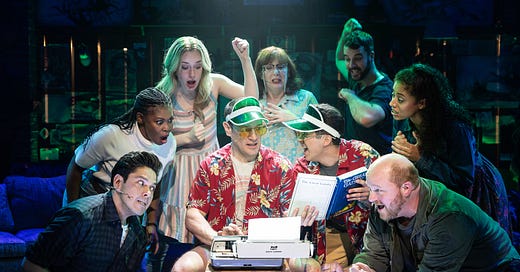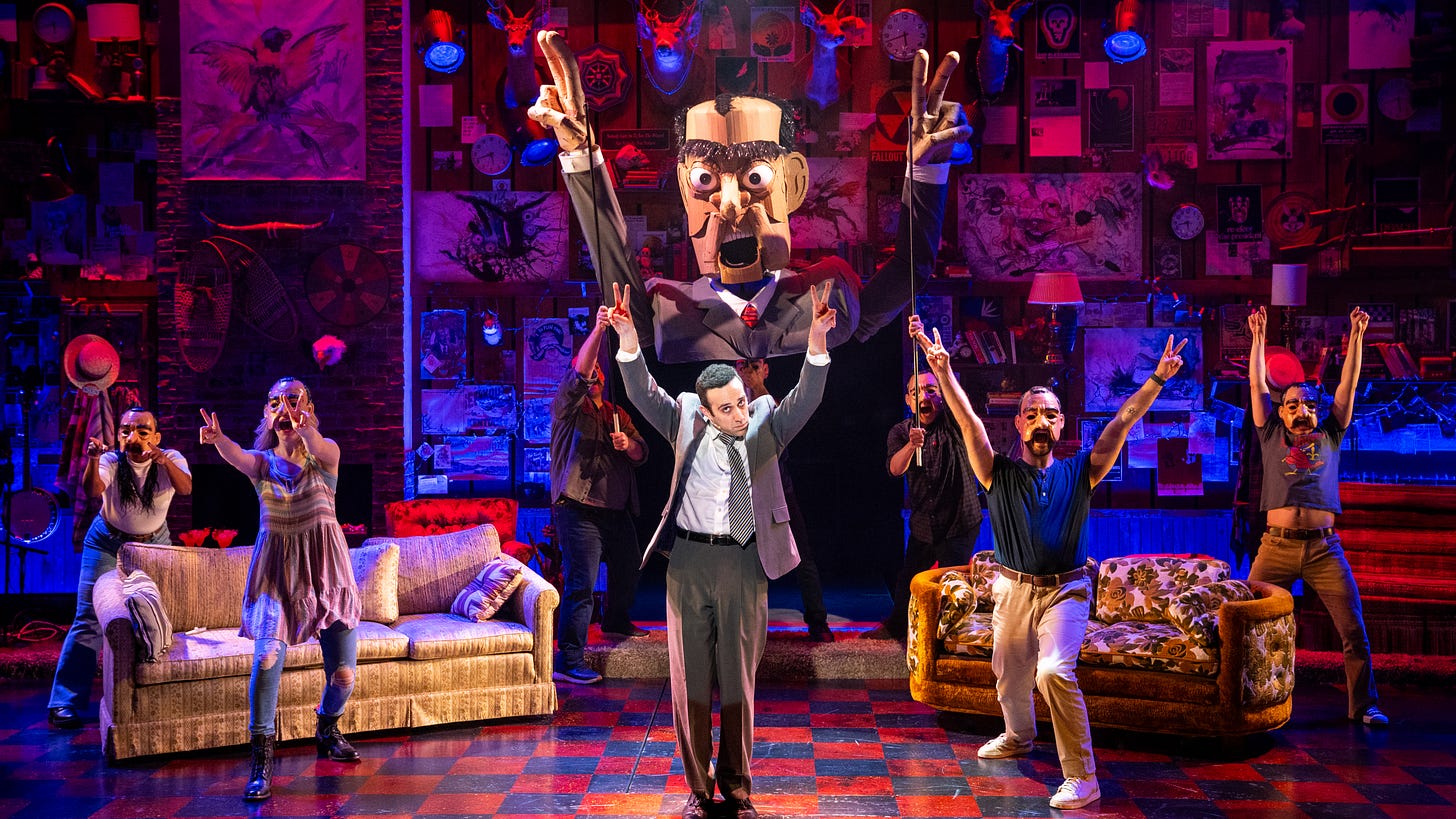Hop on the rollercoaster ride and join Hunter S. Thompson in this wacky, action-packed memory play of his wild life and tragic end. “The Untitled Unauthorized Hunter S. Thompson Musical,” playing at Signature Theatre, is an inventive show which succeeds in breaking most of the rules of a bio-musical and finds clever ways to tell this man-against-the-machine story.
Thompson will likely be more familiar to those alive in the 1970s, but this is no impediment to enjoying the show. The uninitiated even find a stand-in for ourselves at the top of the play, when a decidedly square man in a suit demands to know who exactly is this guy? A journalist, a druggie, a personality, an activist, a feminist, a terrible husband and father, an influencer—all are correct answers, as we’ll come to learn. Most active in the 1960s-1970s, he wrote “gonzo journalism” books and articles, a genre he pioneered that puts the journalist at the center of the story. “Fear and Loathing in Las Vegas,” later adapted into a film, is one of his well-known works. It paints a bleak picture of gamblers, while also detailing the major drug trip he was on while he reported the story.

Eric William Morris plays the character’s intensity with just the right dose of weird vibes while avoiding becoming a caricature of himself. Joe Iconis (music, lyrics, and book) and Gregory S. Moss (book) set the story in Thompson’s home in Colorado on the day he’ll die—“two hours and 30 minutes—including a 15 minute intermission—from now,” he helpfully informs us, in the first of many smart fourth-wall-breaking moments. He is surrounded by characters from his life who, he tells us, live in his head, a sort-of Greek chorus of his thoughts. “Tick, tick, tick,” they whisper periodically, reminding us of his time running out.
While at first he presents his life through a rose-colored, self-aggrandizing lens, by the second half, things turns much darker, as he confronts the ways he hurt others and fell short of his own potential. This is where the show really departs from a traditional, celebratory bio-musical, and it’s particularly compelling watching the psychological drama as he realizes his own failings.

But first we witness his rise: starting out weird even as a kid, though exactly what it is about him that keeps him from fitting in is glazed right over. He gets and loses jobs with traditional media publications; rolls with a motorcycle gang for a while, writing a book about them; meets, marries, and has a child with his wife Sandy; falls in with some hippies in San Francisco; and more.
The non-linear storytelling suits the character’s messy life. The second act has less plot but a more interesting character arc. Thompson takes on his chief nemesis Richard Nixon, going all out for McGovern in the 1972 presidential election. When his man loses, he unravels—losing his friends, publisher, and wife—as the characters sing to him “you wanted to be a writer but now you’re just a Halloween mask” in one of the show’s many bangers.

The show can feel random and frenetic as it bounds along. But director Christopher Ashley steers us through the sprawling story with total clarity and good old-fashioned creativity. His hard-working ensemble quickly shifts to new characters, years, and scenes with simple costume additions (from designer Toni-Leslie James), changes in lighting (from designer Amanda Zieve), and so, so many props, pulled out of every nook and cranny on the maximalist set (by Wilson Chin). I don’t envy the props master on this show! And there are puppets—lots of puppets.
A great example of the show’s innovative storytelling is in the Kentucky Derby scene. Thompson is on assignment to cover the race, though all his notes are about the crowd. One actor spins a model of a track while two others hold horse puppets above it; as the track spins and the horses move up and down, it creates an effective illusion of a horse race. An announcer’s narration turns the race into a metaphor for Thompson’s rush to write the article, as his publisher repeatedly calls to remind him of his deadline. The whole scene is an exciting marriage of music, dialogue, and effective direction that advances story and character without every feeling effortful.
Every member of the ensemble plays at least one named character from Thompson’s life and each gets their own song. These sometimes seem unnecessary at first, as with an illustrator who joins Thompson to cover the Kentucky Derby (played by Jason SweetTooth Williams); but as the show progresses, it becomes clear these are major characters, and so worthy of an introductory song.
George Abud stands out in an all-around strong cast, playing Richard Nixon and every other “square” Thompson confronts—a dramatic foil that brings them both into sharper focus. He nails Nixon’s speech patterns and movements. Giovanny Diaz de Leon provides an earnest and sensitive representation of young Thompson, Thompson’s son, and at the end of the show, a devotee of Thompson. This last role is especially touching, as he embodies Thompson’s influence on future generations. Tatiana Wechsler paints a nuanced picture of Thompson’s wife, Sandy, who has her own passions but finds herself mostly working to support her husband. But this is really an ensemble show—the whole cast is nearly always on stage unless they are changing costumes—and they bring to life dozens of characters with unflagging energy and skill.
Iconis, most well-known for his musical “Be More Chill,” which played on Broadway in 2019, has written a totally groovy score—pop/rock with a mix of styles suited to character and setting, like a hippie number for the San Francisco flower children Thompson meets, or a hard rock tune for the Rolling Stone editor’s introduction. Nixon’s second act opener, “Let’s beat their ass,” is jazzy—connoting his older, out-of-touch vibe. The songs are lyrically clever and flow easily through scenes, not beholden to any particular form. An early song about Thompson copying out “The Great Gatsby” word-for-word gets its initial beat from pecks on a typewriter.
Thompson is frequently frustrated by the course of American politics and culture: “Why do we keep returning the book to the library in worse shape than we found it?” he says at one point. The act one closer has him optimistically singing that things get “better and worse and better and worse,” hoping that the ‘better’ prevails. In his ultimate reckoning with his legacy, he is crushed by the idea that Nixon and the ideals he stood for ‘won.’ As Nixon-imagined-by-Thompson says, people don’t even know Thompson’s name, but look at the state of America now: Nixon’s ideals are ascendant. This crushes Thompson, but the musical’s creators end on a more positive note, showing the diffuse influence Thompson—and anyone who fights for justice—can have. “Ka-Boom,” the ensemble sings, using the metaphor of a firework that can be seen by many even if they don’t know who set it off. We may not know Hunter S. Thompson’s name, but his influence, this show asserts with fabulous flair, is all around us.
Playing through July 13 at Signature Theatre in Arlington, VA. 2 hr and 40 min with intermission.







